As we head into late summer, balancing a busy schedule with healthy eating can be difficult. Here are three quick and easy dinner recipes you can make in less than 30 minutes, giving you more time for fun summer activities!
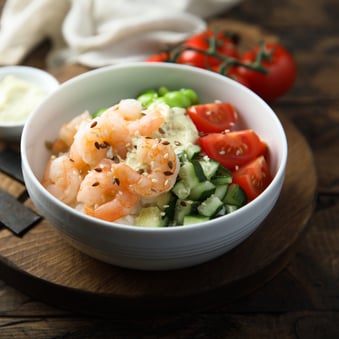 Shrimp Sushi Bowl
Shrimp Sushi Bowl
Servings: 4
5 TB light mayonnaise
2 tsp red curry paste
10 ounces (2 standard packages) frozen riced cauliflower
3 TB sesame oil
1½ lbs uncooked shrimp, peeled and deveined
2 garlic cloves, minced
1 tsp salt
1 medium ripe avocado, seeded, peeled, and sliced
1 medium cucumber, sliced
½ cup julienned carrots
2 green onions, thinly sliced
1 lime, sliced into wedges
- In a small bowl, mix mayonnaise and red curry paste.
- Prepare riced cauliflower according to package directions.
- In a large skillet, heat oil over medium heat. Add shrimp and cook until pink, or about 5–7 minutes. Add garlic and salt and cook for 1 additional minute. Remove from heat.
- Divide cauliflower among 4 bowls. Top each bowl with shrimp, avocado, cucumber, carrot, and green onion. Drizzle each bowl with curry mayonnaise mixture and garnish with lime.
Nutrition Facts: 377 calories, 22g total fat (3.5g saturated fat), 14g carbohydrate (5g fiber, 4g sugar) and 32g protein.
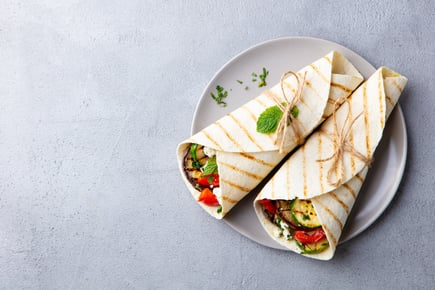 Grilled Zucchini Hummus Wrap (Vegan)
Grilled Zucchini Hummus Wrap (Vegan)
Servings: 2
1 zucchini, sliced
Salt and pepper, to taste
1 TB olive oil
1 medium tomato, sliced (or 1 handful cherry tomatoes)
⅛ cup sliced red onion
1 cup kale
2 slices white cheddar cheese
2 large tortillas
4 tablespoons hummus (any flavor)
- Heat a skillet over medium heat.
- Toss zucchini in olive oil and sprinkle with salt and pepper. Add to skillet and cook for 3 minutes before flipping and cooking for an additional 2 minutes.
- Remove zucchini from skillet and reduce heat to low. Heat tortillas one at a time in skillet for 1 minute each.
- Remove tortillas from skillet and assemble wraps with sliced zucchini, tomato, onion, kale, 1 slice of cheese, and 2 TB hummus. Wrap tightly and serve.
Nutrition Facts: 366 calories, 20g total fat (6g saturated fat), 660mg sodium, 38g carbohydrates (7.5g fiber, 6g sugar), and 13.5g protein.
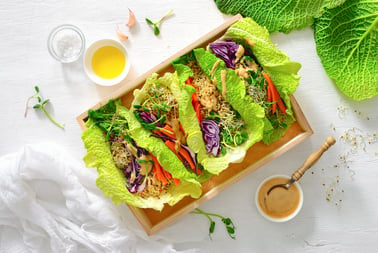 Chicken and Cucumber Lettuce Wraps with a Simple Peanut Sauce
Chicken and Cucumber Lettuce Wraps with a Simple Peanut Sauce
Servings: 4 (2 lettuce wraps per serving)
¼ cup creamy peanut butter
2 TB low-sodium soy sauce
2 TB honey
2 TB water
2 tsp toasted sesame oil
2 tsp olive oil
3 scallions, sliced (separate whites and greens)
1 Serrano pepper, seeded and minced
1 TB minced fresh ginger
2 tsp minced fresh garlic
16 ounces ground chicken breast
1 cup diced jicama
16 Bibb lettuce leaves
1 cup cooked brown rice
½ medium English cucumber, thinly sliced
½ cup fresh cilantro
lime wedges, for serving
- Whisk peanut butter, soy sauce, honey, water, and sesame oil in a small bowl.
- In a large nonstick skillet, heat olive oil over medium heat. Add scallion whites, Serrano pepper, ginger, and garlic and cook until slightly soft, or about 2 minutes. Add chicken and cook until cooked through, about 3–4 minutes.
- Add the peanut sauce to the chicken mixture and cook until sauce has thickened, about 3 minutes. Remove from heat and stir in jicama and scallion greens.
- Prepare lettuce wraps by dividing rice, chicken mixture, cucumber, and cilantro among the each lettuce leaves. Serve with lime wedge garnish.
- Nutrition Facts (per 2 lettuce wraps with sauce): 495 calories, 19g fat (4g saturated fat), 400mg sodium, 39g carbohydrates (6.5g fiber, 14g total sugar, 8.5g added sugar), 44g protein.
This blog was written by Lindsey Recker, MS, Registered Dietitian. To learn more about the NIFS bloggers, click here.


 With the new school year upon us, it’s time to start thinking about “back to school” fitness. Summer was a time for adventure, vacation, trying new foods, and so much more. Although all that stuff is fun, it can get us out of a routine. As a newly graduated college student, I know how much a routine helped me stay on track for my classes. One thing I always included was exercise. Having consistent workouts is the first step toward a disciplined life.
With the new school year upon us, it’s time to start thinking about “back to school” fitness. Summer was a time for adventure, vacation, trying new foods, and so much more. Although all that stuff is fun, it can get us out of a routine. As a newly graduated college student, I know how much a routine helped me stay on track for my classes. One thing I always included was exercise. Having consistent workouts is the first step toward a disciplined life. 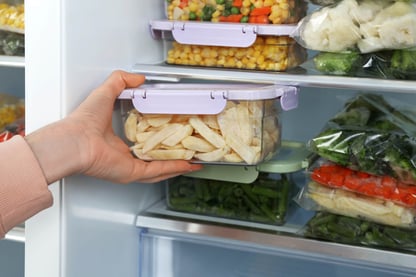 When I say “meal prep,” do you picture hours upon hours in the kitchen, a stockpile of containers, and food that you are sick of by week’s end? PAUSE right there! I am here to tell you that meal prep does not have to be that way. It does not have to be too time-consuming or hard, and you don’t have to eat the exact same meal over and over.
When I say “meal prep,” do you picture hours upon hours in the kitchen, a stockpile of containers, and food that you are sick of by week’s end? PAUSE right there! I am here to tell you that meal prep does not have to be that way. It does not have to be too time-consuming or hard, and you don’t have to eat the exact same meal over and over. 
 Welcome to the final installment of the productivity series. If you need a second to catch up, check out these posts regarding
Welcome to the final installment of the productivity series. If you need a second to catch up, check out these posts regarding 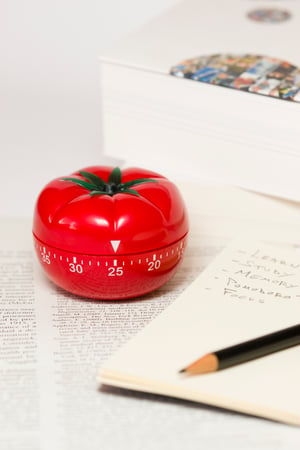 Welcome to the third installment of the productivity hacks series. Last time, I tackled the subject of the
Welcome to the third installment of the productivity hacks series. Last time, I tackled the subject of the  Welcome back to school! Or, if you are new to the college experience, welcome to your first adventure in time management and balancing your life. This not only includes your academics and social life, but other areas that go under the radar as less important. I’m talking about fitness and wellness. College and university fitness centers are usually well populated with individuals with a wide variety of goals ranging from stress reduction to spring break abs, to meeting people.
Welcome back to school! Or, if you are new to the college experience, welcome to your first adventure in time management and balancing your life. This not only includes your academics and social life, but other areas that go under the radar as less important. I’m talking about fitness and wellness. College and university fitness centers are usually well populated with individuals with a wide variety of goals ranging from stress reduction to spring break abs, to meeting people.